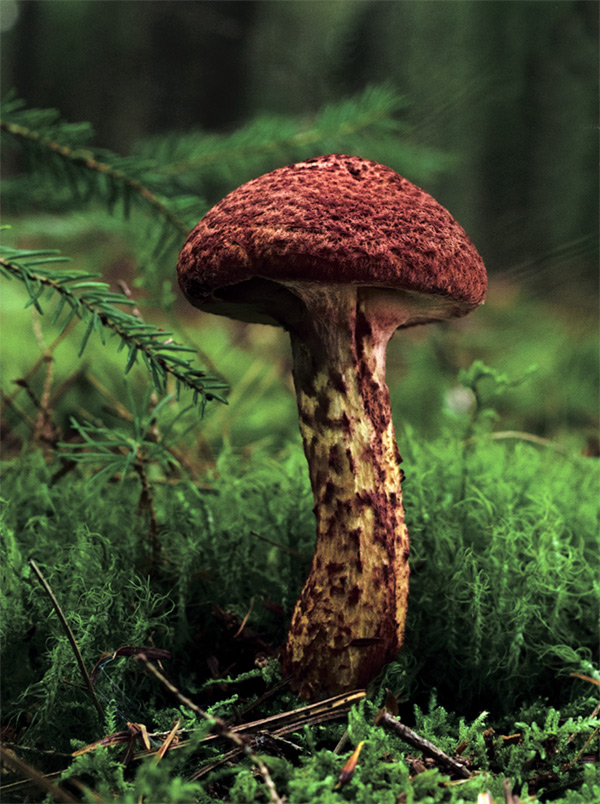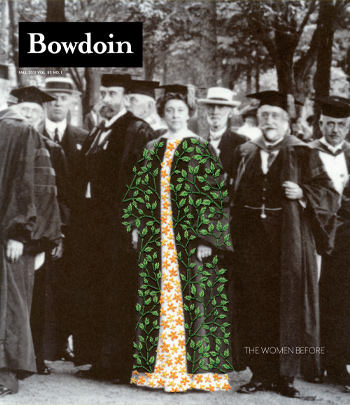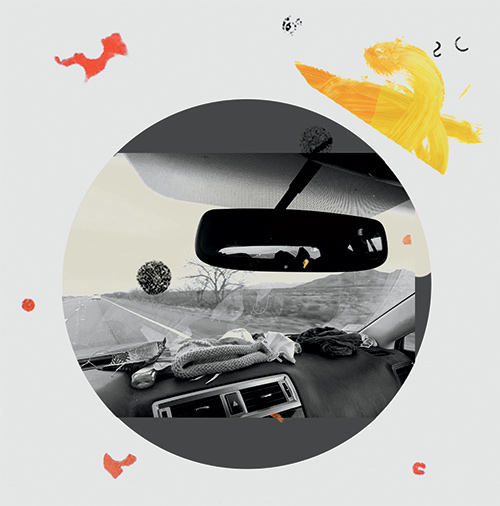Mainely Mushrooms
By Edgar Allen Beem P’13 for Bowdoin MagazineLawns, fields, and forests all over Maine were covered with a bumper crop of fruiting fungi this summer and fall. It wasn’t difficult getting in touch with the Maine Mycological Association (MMA) to find out why.
As it turns out, the library of the MMA is housed in the Gibson Hall office of Delmar Small, manager of budgets, concerts, and instruments for the Bowdoin music department and vice president of the MMA. Small explained that the cool, wet summer was responsible for the abundance of fungi (both Portland and Bangor recorded their wettest month of July on record), and “that many species fruit in the fall—more in the fall in fact than the summer.” A full 90 percent of native Maine mushrooms are visible in autumn. Plentiful fungi is a good sign. Mushrooms are the fruit of the mycelium, a mostly subterranean network of nutrients and communication between trees and plants, and their presence indicates a healthy soil.

“This lovely character is Suillus spraguei, the Painted Bolete,” says Delmar Small. “The Painted Bolete is not a gilled mushroom, rather it has large yellow pores under the cap. When the mushroom is young, as in this photo, the pores are covered by a veil. As the cap expands, the red outer layer cracks, and the underlying surface shows through, hence the name ‘painted.’”
Photographer Tristan Spinski found this specimen about thirty minutes east of Bangor along Route 9.
- Foraging for mushrooms increased in popularity during the pandemic. Membership in the Maine Mycological Association (MMA) tripled from 100 to 300 during the pandemic, and a Facebook group called Maine Mushrooms now has 13,800 members.
- There are some 27,000 species of mushrooms worldwide. The MMA has identified 2,500 of them in Maine. There are at least nine mushroom farms in the state, growing popular Maine varieties such as porcini, oyster, chanterelle, black trumpet, hen, and chicken of the wood, along with an estimated 200 commercial wild mushroom harvesters.
- In 2011, an act to establish the Maine Wild Mushroom Harvesting Certification Program was passed by both houses of the state legislature, but rejected by Governor Paul LePage who refused to appoint the committee to oversee certification. The law would have required mushroom foragers to be certified and contained a list of twenty-five wild mushrooms approved for commercial sale.
- Shana Stewart Deeds, Bowdoin laboratory instructor in biology and environmental sciences, often teaches about mushrooms in ecology classes. “Mushrooms are one of the major decomposers,” Deeds says of the function mushrooms serve in the eco-system. But some mushrooms, such as the matsutake, are what are called mycorrhizal fungi and are associated with the roots of 90 percent of plants in a symbiotic relationship that enables plants to obtain more moisture and nutrients.
- On his website Mushroom-Collecting.com, David Spahr, aka the “Mushroom Maneiac,” explains matsutake are highly prized mushrooms and that “although they are called the ‘pine mushroom,’ they tend to grow mostly under eastern hemlock in Maine.”
- Only about 3 percent of wild mushrooms are poisonous. On average, there are only three deaths a year in the United States from toxic mushrooms. The most common mistake mushroom foragers make is confusing toxic jack-o’-lantern mushrooms (which are orange) for delicious golden chanterelles (which are yellow). Poisonous mushrooms primarily damage liver cells.
- In Maine, the Northern New England Poison Center at Maine Medical Center (800-222-1222) in Portland reported sixty-two mushroom “exposures” in 2018, fifty-nine in 2019, forty-six in 2020, and forty-five through August of this year. In 2008, two Portland chefs mistook poisonous lilac-brown boletes for porcini mushrooms and spent some time in the hospital as a result.
- Gary M. Pendy Sr. Professor of Social Sciences Jean Yarbrough cooks with the mushrooms she forages. “It’s a great pleasure to make a dish for people they wouldn’t be able to get anywhere else,” says Yarbrough, whose recipes have included maitake risotto, hedgehog tarts, scallops with black trumpets, and lobster with matsutake in a dashi reduction. She takes any mushrooms she is unsure about to Delmar Small for identification.
- Only three states have an official state mushroom. Minnesota adopted the sponge-like morel in 1984. Oregon named the Pacific golden chanterelle its state mushroom in 1999. And Texas named the Texas Star, aka Devil’s Cigar, its state mushroom just this year.
- Greg Marley, author of two books about Northeastern mushrooms and the person New England poison centers call when they have a mushroom to identify, says that based on a survey he did of foragers, the golden chanterelle would be a logical choice for a Maine state mushroom as well. “[It’s] the favorite edible mushroom in this state and probably New England,” says Marley. “Second would be the black trumpet.”
- The Northeast Mycological Federation, comprising twenty clubs from Canada to Pennsylvania, held its thirty-eighth annual Samuel Ristich Mycological Foray at Bowdoin College in 2014. The four-day foray, which draws as many as 200 mushroom hunters, is scheduled to return to Maine in 2023, possibly at Gould Academy in Bethel.
- Samuel Ristich (1915–2008) was a Cornell mycologist who retired to North Yarmouth, Maine, in 1980 and founded the Maine Mycological Association in 1985. He discovered a new mushroom species in Maine in 1983, the small white Amanita ristichii, which is named for him and grows only in Quebec, New Hampshire, and Maine. Many amanitas are poisonous, even deadly, but it is unknown whether Amanita ristichii, which fruits in July and August, is edible. A mystery mushroom for Maine?
- For those who want to learn more about mushrooms, Greg Marley and MMA president Michaeline Mulvey teach a five-day “Mushroom Camp,” Mushroom Identification for the Novice, each summer at Eagle Hill Institute in Steuben, Maine.
- Key publications about mushrooms in Maine include Edible and Medicinal Mushrooms of New England and Eastern Canada, by David S. Pahr of Washington, Maine; Mushrooms for Health, by Greg Marley of Rockland; Foraging Mushrooms Maine, by Tom Seymour of Waldo; and National Aububon Society Field Guide to North American Mushrooms.

This story first appeared in the Fall 2021 issue of Bowdoin Magazine. Manage your subscription and see other stories from the magazine on the Bowdoin Magazine website.



